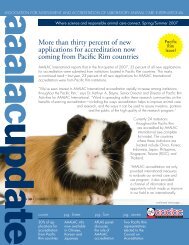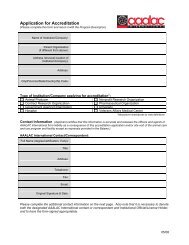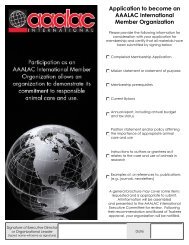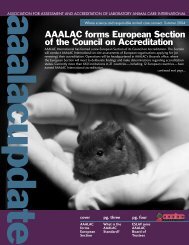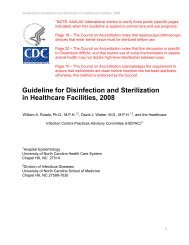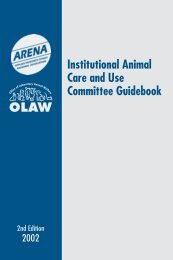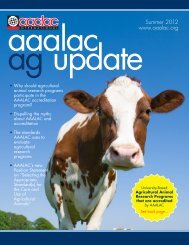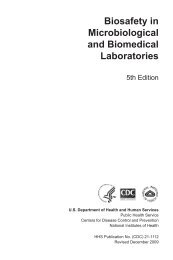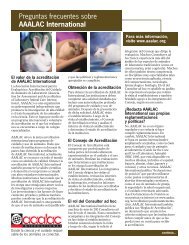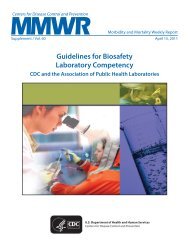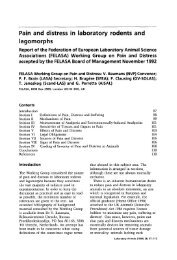Low resolution PDF - Aaalac
Low resolution PDF - Aaalac
Low resolution PDF - Aaalac
Create successful ePaper yourself
Turn your PDF publications into a flip-book with our unique Google optimized e-Paper software.
Summer 2004continued from page one ...AAALAC forms agriculturaladvisory committee“The ARPAAC is providing instrumental advice that will allow usto better recognize and address the issues facing our colleaguesconducting agricultural animal research,” said John G. Miller,D.V.M., executive director of AAALAC International. “It’s anoutstanding group of advisors and we are extremely appreciativeof their participation.”AAALAC has published a summary of the committee’srecommendations so that others may comment on them andprovide additional input. Some highlights of the summaryinclude ...Benefits—why agricultural animal researchprograms should participate in the AAALACaccreditation programSome members of the advisory committee representinstitutions that already participate in the accreditationprogram. Here’s what those members say about the benefitsof AAALAC accreditation …2• Accreditation promotes—and validates—high standards for research and animalcare.• Accreditation provides publicaccountability• Accreditation offers an opportunity forin-depth program assessment• Accreditation can identify the need for—andfacilitate the acquisition of—additionalresources• Accreditation provides a positive image amongresearch fundersKey issues and challengesfor agricultural animal research andteaching programsIn terms of participating in the accreditation program,agricultural animal research programs face several unique issuesand challenges identified by the committee:• Cost of accreditation• Institutional structure and complex reporting that makesworking toward accreditation difficult• Investigator resistance to external oversight/controlQuestions or comments?E-mail accredit@aaalac.org.“Accreditationputs agriculturalanimal researchprograms on parwith biomedicalresearch programsin terms of havinga well-managed,well-documentedand accountableanimal care anduse program.”Moving forward—action itemsBased on the feedback from the committee, AAALAC hasdeveloped the following action items that will lead toimprovements and enhancements to AAALAC’s programs,services, and communications efforts, based on the specificneeds and concerns of the agricultural animal researchcommunity. These action items include:• Develop new education and mediation servicesAAALAC will look to develop new on-site educationalworkshops that institutions can request. The workshops willeducate staff, investigators and administrators on AAALACstandards and processes, and address specific issues andchallenges facing the institution. AAALAC will also consider“mediation services” in which key institutional representativescome together—including investigators, administrators,faculty and animal care staff—to meet with an AAALACrepresentative who serves as a moderator, helping to bridgecommunication gaps and get all parties working towardmutually agreed upon animal care and use goals.• Provide more data and benchmarks specificto agricultural animal research programsAAALAC will begin extracting more “best practices” dataspecific to agricultural animal research programsand provide trends data, benchmarking tools,“how to” articles, and success stories thatagricultural institutions can use to help improvetheir programs.• Make the AAALAC accreditation processmore agriculture-specificThis includes recruiting additional ad hocConsultants (those who assist with site visits)who have expertise in agricultural animal scienceand administration; and considering changingthe name of the organization to reflect theinclusion of agricultural animal research in theaccreditation program.• Clearly communicate the differentapproaches to accrediting laboratory vs.agricultural animal programsAAALAC will find additional and more effective ways tocommunicate the different approaches AAALAC uses inaccrediting laboratory and agricultural animal programs.• Do a better job of reaching out to theagricultural animal research communityAAALAC will look for new opportunities to reach out to theagricultural animal research community to better informthem of the benefits of accreditation and dispel the mythsand misperceptions that exist. This includes participatingin more conferences likely to be attended by animalscience department heads, faculty, investigators and otheradministrators, and creating new materials and educationaltools for the agricultural animal research community.



